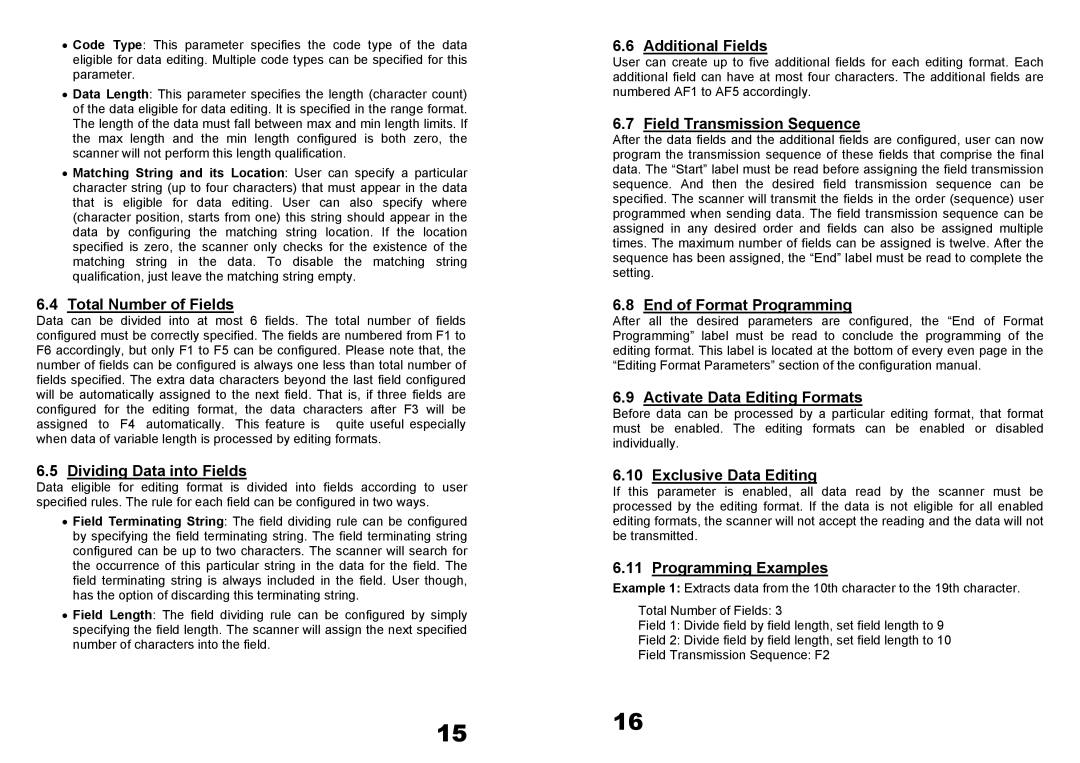•Code Type: This parameter specifies the code type of the data eligible for data editing. Multiple code types can be specified for this parameter.
•Data Length: This parameter specifies the length (character count) of the data eligible for data editing. It is specified in the range format. The length of the data must fall between max and min length limits. If the max length and the min length configured is both zero, the scanner will not perform this length qualification.
•Matching String and its Location: User can specify a particular character string (up to four characters) that must appear in the data that is eligible for data editing. User can also specify where (character position, starts from one) this string should appear in the data by configuring the matching string location. If the location specified is zero, the scanner only checks for the existence of the matching string in the data. To disable the matching string qualification, just leave the matching string empty.
6.4Total Number of Fields
Data can be divided into at most 6 fields. The total number of fields configured must be correctly specified. The fields are numbered from F1 to F6 accordingly, but only F1 to F5 can be configured. Please note that, the number of fields can be configured is always one less than total number of fields specified. The extra data characters beyond the last field configured will be automatically assigned to the next field. That is, if three fields are configured for the editing format, the data characters after F3 will be assigned to F4 automatically. This feature is quite useful especially when data of variable length is processed by editing formats.
6.5Dividing Data into Fields
Data eligible for editing format is divided into fields according to user specified rules. The rule for each field can be configured in two ways.
•Field Terminating String: The field dividing rule can be configured by specifying the field terminating string. The field terminating string configured can be up to two characters. The scanner will search for the occurrence of this particular string in the data for the field. The field terminating string is always included in the field. User though, has the option of discarding this terminating string.
•Field Length: The field dividing rule can be configured by simply specifying the field length. The scanner will assign the next specified number of characters into the field.
6.6Additional Fields
User can create up to five additional fields for each editing format. Each additional field can have at most four characters. The additional fields are numbered AF1 to AF5 accordingly.
6.7Field Transmission Sequence
After the data fields and the additional fields are configured, user can now program the transmission sequence of these fields that comprise the final data. The “Start” label must be read before assigning the field transmission sequence. And then the desired field transmission sequence can be specified. The scanner will transmit the fields in the order (sequence) user programmed when sending data. The field transmission sequence can be assigned in any desired order and fields can also be assigned multiple times. The maximum number of fields can be assigned is twelve. After the sequence has been assigned, the “End” label must be read to complete the setting.
6.8End of Format Programming
After all the desired parameters are configured, the “End of Format Programming” label must be read to conclude the programming of the editing format. This label is located at the bottom of every even page in the “Editing Format Parameters” section of the configuration manual.
6.9Activate Data Editing Formats
Before data can be processed by a particular editing format, that format must be enabled. The editing formats can be enabled or disabled individually.
6.10Exclusive Data Editing
If this parameter is enabled, all data read by the scanner must be processed by the editing format. If the data is not eligible for all enabled editing formats, the scanner will not accept the reading and the data will not be transmitted.
6.11Programming Examples
Example 1: Extracts data from the 10th character to the 19th character.
Total Number of Fields: 3
Field 1: Divide field by field length, set field length to 9
Field 2: Divide field by field length, set field length to 10
Field Transmission Sequence: F2
15 16
